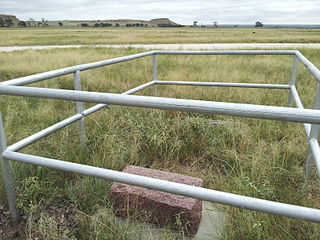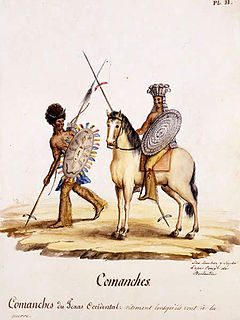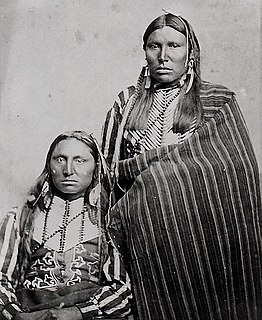 W
WThe First Battle of Adobe Walls was a battle between the United States Army and American Indians. The Kiowa, Comanche and Plains Apache tribes drove from the battlefield a United States Expeditionary Force that was reacting to attacks on white settlers moving into the Southwest. The battle, on November 25, 1864, resulted in light casualties on both sides but was one of the largest engagements fought on the Great Plains.
 W
WThe Second Battle of Adobe Walls was fought on June 27, 1874, between Comanche forces and a group of 28 U.S. bison hunters defending the settlement of Adobe Walls, in what is now Hutchinson County, Texas. "Adobe Walls was scarcely more than a lone island in the vast sea of the Great Plains, a solitary refuge uncharted and practically unknown."
 W
WThe Antelope Hills expedition was a campaign from January to May 1858 by the Texas Rangers and members of other allied Native American tribes against Comanche and Kiowa villages in the Comancheria. It began in West Texas and ended in a series of fights with the Comanche tribe on May 12, 1858, at a place called Antelope Hills by Little Robe Creek, a tributary of the Canadian River in what is now Oklahoma. The hills are also called the "South Canadians", as they surround the Canadian River. The fighting on May 12, 1858, is often called the Battle of Little Robe Creek.
 W
WThe Battle of Blanco Canyon was the decisive battle of Col. Ranald S. Mackenzie's initial campaign against the Comanche in West Texas, and marked the first time the Comanches had been attacked in the heart of their homeland. It was also the first time a large military force explored the heart of Comancheria. On 12 August 1871 Mackenzie and Colonel Benjamin Grierson were asked by Indian Agent Lawrie Tatum to begin an expedition against the Kotsoteka and Quahadi Comanche bands, both of whom had refused to relocate onto a reservation after the Warren Wagon Train Raid. Col. Mackenzie assembled a powerful force consisting of eight companies of the Fourth United States Cavalry, two companies of the Eleventh Infantry, and a group of twenty Tonkawa scouts.
 W
WThe Buffalo Hunters' War, or the Staked Plains War, occurred in 1877. Approximately 170 Comanche warriors and their families led by Quohadi chief Black Horse or Tu-ukumah left the Indian Territory in December, 1876, for the Llano Estacado of Texas. In February, 1877, they, and their Apache allies, began attacking buffalo hunters' camps in the Red River country of the Texas Panhandle, killing or wounding several. They also stole horses from the camp of Pat Garrett.
 W
WThe Buffalo Soldier Tragedy of 1877, also known as the Staked Plains Horror, occurred when a combined force of Buffalo Soldier troops of the 10th Cavalry and local buffalo hunters wandered for five days in the near waterless Llano Estacado region of northwest Texas and eastern New Mexico during July of a drought year, where four soldiers and one buffalo hunter died.
 W
WThe Comanche–Mexico Wars was the Mexican theater of the Comanche Wars, a series of conflicts from 1821 to 1870. There were large-scale raids into northern Mexico by the Comanche and their Kiowa and Kiowa Apache allies, which left thousands of people dead. The Comanche raids were sparked by the declining military capability of Mexico during the turbulent years after it gained independence in 1821, as well as a large and growing market in the United States for stolen Mexican horses and cattle.
 W
WThe Council House Fight, often referred to as the Council House Massacre, was a decidedly lopsided fight between soldiers and officials of the Republic of Texas and a delegation of Comanche chiefs during a peace conference in San Antonio on March 19, 1840. The meeting took place under an observed truce with the purpose of negotiating the exchange of captives and ultimately facilitating peace after two years of war. The Comanches sought to obtain recognition of the boundaries of the Comancheria, their homeland, while the Texians wanted the release of Texian and Mexican citizens held prisoner by the Comanches.
 W
WThe Battle of Devil's River was an 1857 Indian War skirmish which took place in Texas along the Devils River. A small force of United States Army cavalry defeated an overwhelming force of Comanche braves after an epic journey across the desert.
 W
WDohäsan, Dohosan, Tauhawsin, Tohausen, or Touhason was a prominent Native American. He was War Chief of the Kata or Arikara band of the Kiowa Indians, and then Principal Chief of the entire Kiowa Tribe, a position he held for an extraordinary 33 years. He is best remembered as the last undisputed Principal Chief of the Kiowa people before the Reservation Era, and the battlefield leader of the Plains Tribes in the largest battle ever fought between the Plains tribes and the United States.
 W
WThe Great Raid of 1840 was the largest raid ever mounted by Native Americans on white cities in what is now the United States. It followed the Council House Fight, in which Republic of Texas officials attempted to capture and take prisoner 33 Comanche chiefs who had come to negotiate a peace treaty, killing them together with two dozen of their family and followers. The Comanche tribe was supposed to have brought white hostages as their part of the negotiations but only brought one young woman. Arguments and fighting then broke out among the Texans and Comanches. The Texas Officials were determined to force the Comanche to release all white captives among them. To avenge what the Comanche viewed as a bitter betrayal by the Texans, the Comanche war chief Buffalo Hump raised a huge war party of many of the bands of the Comanche, and raided deep into white-settled areas of Southeast Texas.
 W
WIsatai'i, Isatai, or Eschiti was a Comanche warrior and medicine man of the Kwaharʉ band. Originally named Kwihnai Tosabitʉ, after the debacle at Adobe Walls on June 27, 1874, for which he was blamed, he was known as Isatai'i. Isatai'i gained enormous prominence for a brief period in 1873-74 as a prophet and "messiah" of Native Americans. He succeeded, albeit temporarily, in uniting the autonomous Comanche bands as no previous Chief or leader had ever done. Indeed, his prestige was such that he was able to organize what was said to be the first Comanche sun dance, a ritual that his tribe had not previously adopted.
 W
WThe Battle of Little Robe Creek, also called the Battle of Antelope Hills, took place on May 12, 1858. It actually was a series of three distinct encounters that took place on a single day, between the Comanches, with Texas Rangers, militia, and allied Tonkawas attacking them. It was undertaken against the laws of the United States at the time, which strictly forbade such an incursion into the Indian Territories of Oklahoma, and marked a significant escalation of the Indian Wars. It also marked the first time American or Texas Ranger forces had penetrated the Comancheria as far as the Wichita Mountains, and Canadian River, and it marked a decisive defeat for the Comanches.
 W
WThe Battle of Lyman's Wagon Train was an incident in 1874, near Canadian, Texas. A 343 acres (139 ha) area at the site was listed on the National Register of Historic Places in 2001 for its information potential as an archeological site. As an archeological resource, the National Register does not disclose the location of the site.
 W
WThe Meusebach–Comanche Treaty was a treaty made on May 9,1847 between the private citizens of the Fisher–Miller Land Grant in Texas, who were predominantly German in nationality, and the Penateka Comanche Tribe. The treaty was officially recognized by the United States government. In 1936, a Recorded Texas Historic Landmark, Marker number 991, was placed in San Saba County to commemorate the signing of the treaty.
 W
WMow-way, was the principal leader and war chief of the Kotsoteka band of the Comanche during the 1860s and 1870s, following the deaths of Kuhtsu-tiesuat in 1864 and Tasacowadi in 1872.
 W
WThe Battle of North Fork or the Battle of the North Fork of the Red River occurred on September 28, 1872, near McClellan Creek in Gray County, Texas, United States. A monument on that spot marks the site of the battle between the Comanche Indians under Kai-Wotche and Mow-way and a detachment of cavalry and scouts under U.S. Army Colonel Ranald S. Mackenzie. There was an accusation that the battle was really an attempt "to make a massacre," as during the height of battle some noncombatants were wounded while mixed in with warriors.
 W
WThe Fort Parker massacre of May 1836, also known as the Fort Parker raid, was an event in which U.S. settlers of the Parker family were killed in an attack by a contingent of Comanche, Caddo, and Wichita fighters. During the attack, Cynthia Ann Parker, then 9-years-old, was captured and spent most of the rest of her life within the Comanche Nation, later marrying Chief Peta Nocona and giving birth to a son, Quanah Parker, who would become a prominent leader of the Comanches and a war leader during the Red River War of 1874–75. Parker’s brother John Richard Parker was also captured and remained with the Comanches for six years before his released was negotiated. He was unable to readapt to Western society and chose to return to the Comanche Nation.
 W
WCynthia Ann Parker, also known as Naduah, was a white woman who was kidnapped in 1836, around age nine, by a Comanche war band which had attacked her family's settlement, and was then discovered and captured by the Texas Rangers, at approximately age 33, when they attacked her adopted tribe. Her Comanche name means "someone found" in English.
 W
WElder John Parker was a Predestinarian Baptist minister, veteran of the American War of Independence, scout and minor diplomat for the American government, famous frontier Ranger. He was among the first settlers of Texas before the Texas Revolution and was killed during the Fort Parker massacre in 1836, along with several members of his extended family.
 W
WThe Battle of Pease River occurred on December 18, 1860, near the present-day town of Margaret, Texas in Foard County, Texas, United States. The town is located between Crowell and Vernon within sight of the Medicine Mounds just outside present-day Quanah, Texas.
 W
WThe Battle of Plum Creek was a clash between allied Tonkawa, militia, and Rangers of the Republic of Texas and a huge Comanche war party under Chief Buffalo Hump, which took place near Lockhart, Texas, on August 12, 1840, following the Great Raid of 1840 as the Comanche war party returned to west Texas.
 W
WThe Red River War was a military campaign launched by the United States Army in 1874 to displace the Comanche, Kiowa, Southern Cheyenne, and Arapaho Native American tribes from the Southern Plains, and forcibly relocate the tribes to reservations in Indian Territory. Lasting only a few months, the war had several army columns crisscross the Texas Panhandle in an effort to locate, harass, and capture highly mobile Native American bands. Most of the engagements were small skirmishes in which neither side suffered many casualties. The war wound down over the last few months of 1874, as fewer and fewer Indian bands had the strength and supplies to remain in the field. Though the last significantly sized group did not surrender until mid-1875, the war marked the end of free-roaming Indian populations on the southern Great Plains.
 W
WSatanta was a Kiowa war chief. He was a member of the Kiowa tribe, born around 1820, during the height of the power of the Plains Tribes, probably along the Canadian River in the traditional winter camp grounds of his people.
 W
WThe Texas–Indian wars were a series of 19th-century conflicts between settlers in Texas and the Southern Plains Natives. These conflicts began when the first wave of European-American settlers moved into Spanish Texas. They continued through Texas's time as part of Mexico, when more Europeans and Anglo-Americans arrived, to the subsequent declaration of independence by the Republic of Texas. The conflicts did not end until thirty years after Texas joined the United States.
 W
WThe Battle of the Two Villages was a Spanish attack on Taovaya villages in Texas and Oklahoma by a Spanish army in 1759. The Spanish were defeated by the Taovaya and other Wichita tribes with assistance from the Comanche.
 W
WThe Trial of Satanta and Big Tree occurred in May 1871 in the town of Jacksboro in Jack County, Texas, United States. This historic trial of Native American War Chiefs of the Kiowa Indians Satanta and Big Tree for the murder of seven teamsters during a raid on Salt Creek Prairie near Jacksboro, Texas, marked the first time the United States had tried Native American Chiefs in a state court. The trial attracted national and international attention. The two Kiowa leaders, with Satank, a legendary third War Chief, were formally indicted on July 1, 1871, and tried shortly thereafter, for acts arising out of the Warren Wagon Train Raid.
 W
WThe Battle of Yellow House Canyon was a battle between a force of Comanches and Apaches against a group of American bison hunters that occurred on March 18, 1877, near the site of the present-day city of Lubbock, Texas. It was the final battle of the Buffalo Hunters' War, and was the last major fight involving the United States and Native Americans on the High Plains of Texas.